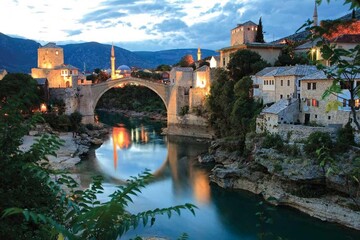

Are you sure?
This bookmark will be removed from all folders and any saved notes will be permanently removed.
Prayer in a former war zone
Mostar in Bosnia and Herzegovina. Panoramic view of Stari Most, or Old Bridge and the river in Mostar. The Old Bridge stood for 427 years, until it was destroyed on November 9, 1993 during the Croat-Bosniak War. Subsequently, a project was set in motion to reconstruct it, and the rebuilt bridge opened on July 23, 2004.
Mostar in Bosnia and Herzegovina. Panoramic view of Stari Most, or Old Bridge and the river in Mostar. The Old Bridge stood for 427 years, until it was destroyed on November 9, 1993 during the Croat-Bosniak War. Subsequently, a project was set in motion to reconstruct it, and the rebuilt bridge opened on July 23, 2004.
Many see Bosnia and Herzegovina as the republic that suffered the most during this hostile time, where war raged for nearly three years. It involved the three main ethnic groups, the Serbs, Croats, and Muslims. As the war intensified, genocide against the Muslims in Bosnia (also known as Bosniaks) was committed largely by nationalist Serbs, and the resulting devastation and damage are still being rectified 20 years later. While Bosnia and Herzegovina was once the triumphant example of peaceful interethnic relations in Yugoslavia, the war deeply entrenched and institutionalized ethnic divisions.
Enjoy 1 free Sentinel article or audio program each month, including content from 1898 to today.

June 11, 2012 issue
View Issue-
Letters
M.M. Bennetts, Carmen Louise Votaw, Carol Logian
-
On your marks...!
Kim Shippey, Senior Staff Editor
-
Spiritual participation in the Olympics
Tony Lobl
-
Completeness and fulfillment
Alistair Budd
-
Shining like stars
Heather Hayward
-
Prayer in a former war zone
Sarah Matusek
-
Life lessons
Janet Cowgill Distel
-
The immediacy of healing
Betsie Ellington Tegtmeyer
-
Struggling with clutter?
Heather Woodman
-
Golf goals and God
Parker Engel
-
'Pa' for the course
Brian Kissock
-
A debate deserving deep prayer
Margaret Rogers
-
Disarming ethnic terrorism
Annette Kreutziger-Herr
-
Rely on spiritual reasoning
Maya Dietz
-
A healing support to family
Toni Gaspard
-
Christians and Muslims working together
Frederick Nzwili
-
Returning to religious roots
Cathy Lynn Grossman
-
Healed after a trampoline fall
Mark Asher
-
Pain stops; resentment toward mother fades
Name withheld
-
Where wealth and unselfishness meet
The Editors

